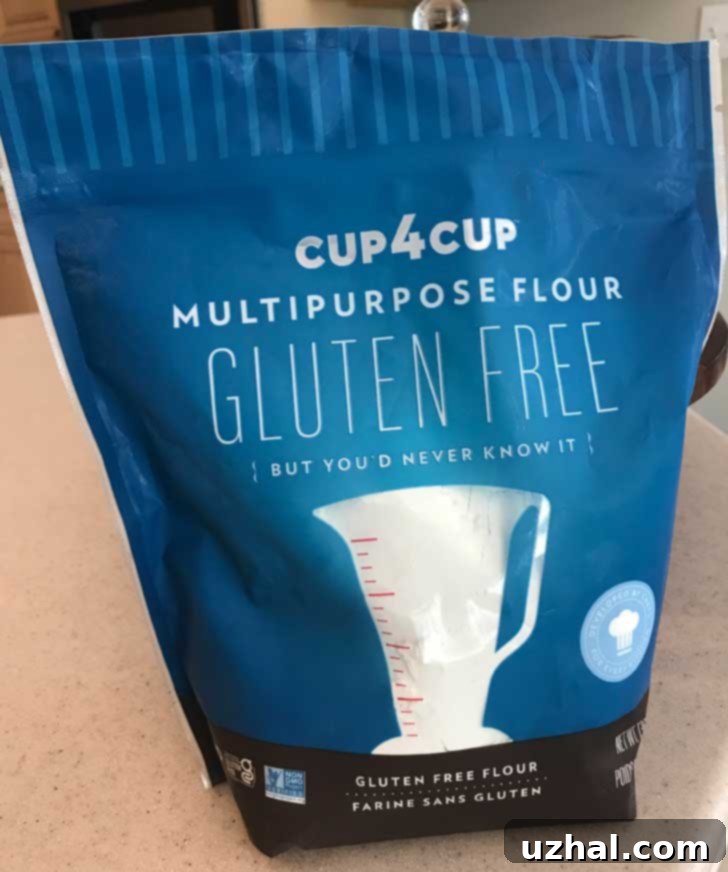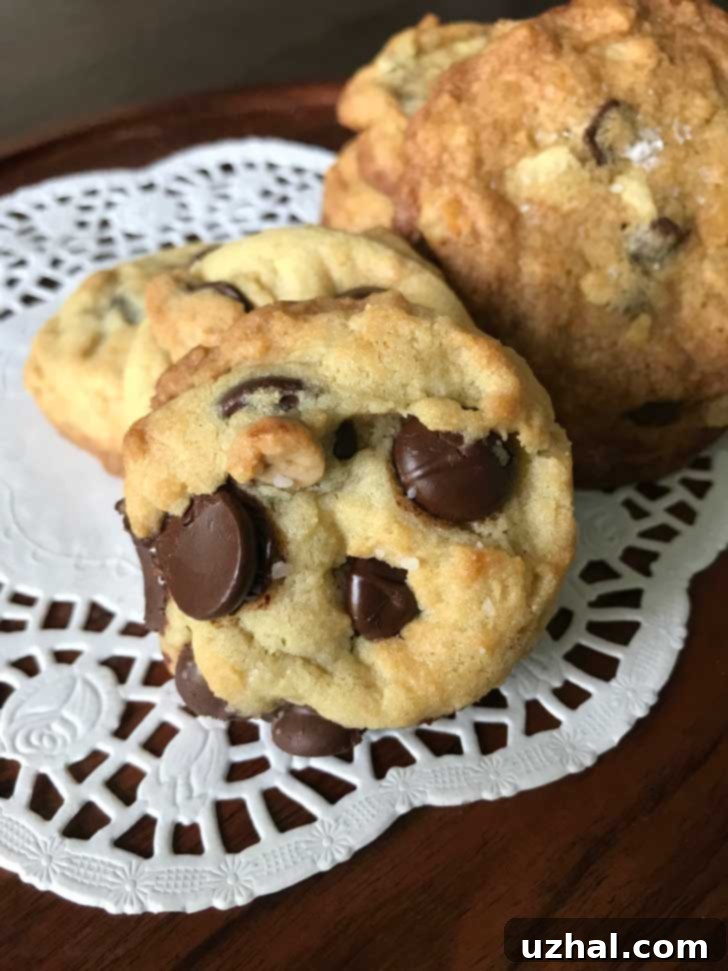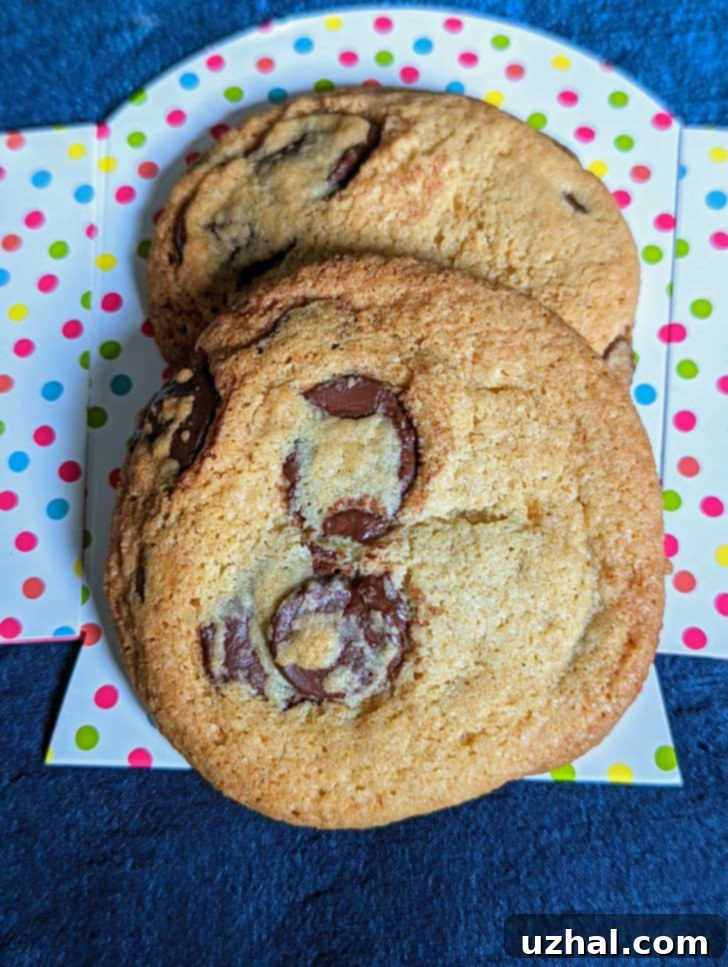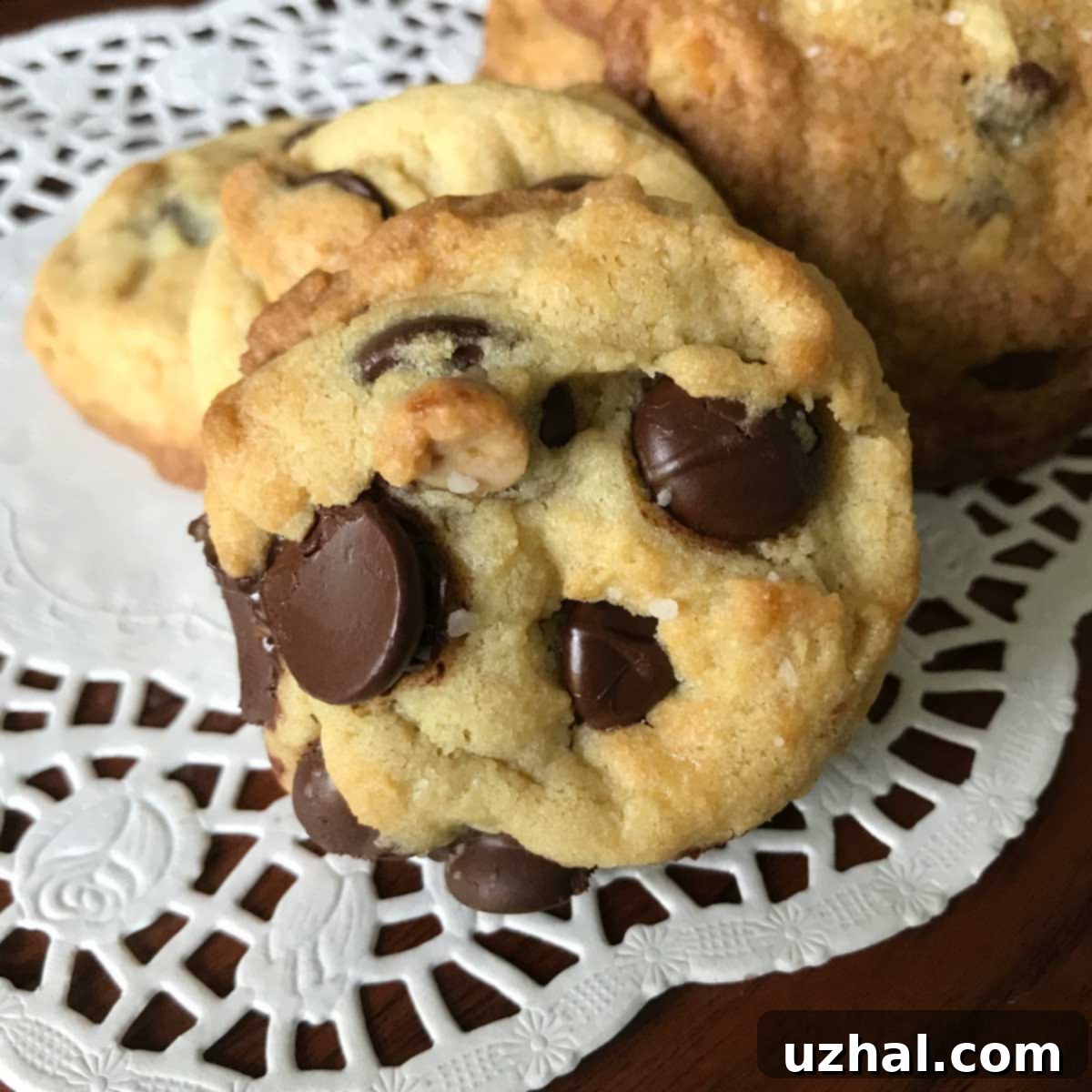Unlock Perfect Gluten-Free Baking: An In-Depth Review of Thomas Keller’s Cup4Cup Multipurpose Flour
For many home bakers navigating the world of gluten-free recipes, finding a reliable, high-quality flour blend that performs like traditional all-purpose flour can be a significant challenge. Brands like King Arthur and Bob’s Red Mill 1:1 have long been staples in my kitchen, often mentioned whenever I share a new gluten-free creation. However, a reader recently suggested I venture into new territory and try Thomas Keller’s Cup4Cup Multipurpose Flour. After much anticipation, I finally did, and I’m excited to share my findings!
This isn’t a sponsored post; it’s simply an honest, firsthand account of my experience using Cup4Cup in one of my favorite recipes: thick, soft, chocolate chip cookies. My goal is to provide a comprehensive review that helps you decide if this premium gluten-free flour is the right addition to your baking pantry. We’ll delve into its unique properties, how it compares to conventional flours, and crucial considerations for those with specific dietary needs.

Understanding Cup4Cup Gluten-Free Multipurpose Flour
Let’s begin with an overview of what makes Cup4Cup stand out. Developed by the acclaimed chefs at Thomas Keller’s renowned restaurants, Cup4Cup is specifically engineered as a 1:1 substitute for traditional all-purpose flour in a wide range of baked goods. Its “multipurpose” designation truly holds, as it’s designed to excel in recipes for cookies, biscuits, cakes, muffins, and more. This makes it an incredibly convenient option for bakers who want to convert their favorite gluten-containing recipes without complicated formula adjustments.
While the company primarily recommends it for non-yeasted baked goods, suggesting it might require “mad baking chemistry skills” for yeast breads, it’s worth noting that their official website actually features two intriguing yeast bread recipes: gluten-free brioche and focaccia. This indicates that with the right technique and understanding of gluten-free dough dynamics, adventurous bakers might indeed find success in expanding its applications, demonstrating its versatility beyond conventional expectations.
A Closer Look: Dairy in Cup4Cup’s Ingredients
One of the most distinctive aspects of Thomas Keller’s Cup4Cup flour blend, and something I initially overlooked, is the inclusion of milk powder in its ingredient list. The blend comprises cornstarch, white rice flour, brown rice flour, tapioca flour, potato starch, xanthan gum, and notably, milk powder. For me, this wasn’t an issue, but it’s a crucial detail for anyone with dairy allergies, lactose intolerance, or those aiming to create vegan baked goods. If your baking plans require a dairy-free or vegan approach, you will, of course, need to opt for a different gluten-free flour blend.
However, if dairy isn’t a concern, the presence of milk powder is actually a key component in Cup4Cup’s superior performance. According to the company’s website, it’s intentionally added to significantly enhance the taste, texture, and overall flavor of baked goods. My own experience confirmed this, as the results were noticeably richer and more nuanced. The milk solids contribute to better browning, a more tender crumb, and a depth of flavor often missing in many other gluten-free blends. This strategic ingredient choice helps Cup4Cup achieve a mouthfeel and richness that closely mimics traditional wheat flour, setting it apart in the gluten-free market.
Here’s a picture of my usual cookies made with all-purpose flour for comparison:

Baking with Cup4Cup: My Chocolate Chip Cookie Test
Now for the most important part: how did Cup4Cup perform in my beloved chocolate chip cookie recipe? The results were genuinely impressive. While the cookies made with Cup4Cup weren’t quite as thick as their all-purpose flour counterparts, they still achieved a delightful chewiness and softness that far exceeded my expectations for a gluten-free cookie. They maintained excellent structural integrity, spreading just enough to create those desirable crinkly edges without becoming flat or greasy.
One notable difference was the browning. The Cup4Cup cookies browned quicker and achieved a beautiful golden hue, suggesting a slight adjustment in baking time or temperature might be beneficial for future batches to prevent over-browning. The texture was a true highlight: wonderfully crispy edges yielding to a soft interior, without veering into the dreaded “cakey” territory often associated with gluten-free baked goods. This balance is precisely what I look for in a perfect chocolate chip cookie. Beyond texture, the flavor truly shone. I felt the cookies had a more pronounced, almost nutty flavor, which I attribute not just to the vanilla paste I used, but also to the intrinsic qualities of the Cup4Cup flour itself, likely enhanced by the milk powder. Even on day two, these cookies tasted remarkably fresh, a testament to the blend’s ability to maintain moisture and flavor over time.

Availability: Where to Purchase Cup4Cup Flour
Finding Cup4Cup flour has become easier over time, though it might still be considered a specialty item in some regions. I successfully located it in the dedicated gluten-free section of my local Wegmans, indicating its presence in larger, well-stocked grocery chains. Beyond physical stores, it’s widely available online, particularly on platforms like Amazon, where it consistently garners excellent reviews. The positive feedback from a broad customer base further reinforces its reputation as a high-performing gluten-free alternative. While it might be priced slightly higher than some other gluten-free blends, its consistent results and 1:1 versatility often justify the investment for serious gluten-free bakers.
An Update on Cup4Cup and Future Baking Adventures
Following my successful initial test, I’m eager to explore the full potential of Cup4Cup. The cookie recipe I’m sharing below is a tried-and-true favorite that adapts beautifully to various flours, including Cup4Cup, all-purpose, or even bread flour. However, I’ve also discovered another fantastic recipe: the one printed directly on the back of the Cup4Cup bag! These cookies are distinctly different from the ones in my standard recipe, offering a unique texture and flavor profile that I believe deserves its own dedicated post. Stay tuned for a deeper dive into that particular recipe, as it highlights yet another facet of Cup4Cup’s impressive versatility.
My Go-To Recipe: Soft Thick Chocolate Chip Cookies
Ultimately, my review of Cup4Cup concludes with high praise. It performed beautifully in these cookies, delivering a result that was both delicious and satisfyingly close to traditional cookies. This recipe is a true workhorse, equally fantastic whether you opt for Cup4Cup, classic all-purpose flour, or even bread flour. It’s not a cookie designed for extravagant presentation or complex techniques; rather, it’s a celebration of simple, comforting flavors and a perfect texture that appeals to everyone.
I love these cookies so much that I shared the recipe with my daughter, Emma (aka Fuzz), to make at school. Her batch, made with all-purpose flour, came with a thoughtfully written note advising everyone not to eat them while warm – a crucial tip, as these cookies genuinely develop their best texture and flavor at room temperature once the chocolate has set. The feedback from her school crowd was overwhelmingly positive, with many specifically praising the “balance of sweet and salty” notes. This balance is key; most of the sweetness comes from the generous amount of chocolate chips, while the dough itself provides a sturdy, flavorful base that holds everything together without being overly sugary.
Expert Tips for Achieving Thick, Soft Chocolate Chip Cookies
-
Butter vs. Margarine: I’ve extensively tested this recipe with both butter and margarine. While I typically prefer butter for baking, I sometimes experiment with margarine to observe its impact on cookie softness and how it interacts with other ingredients. If you choose to use margarine, it is absolutely critical to select a brand with at least 80% fat content, which translates to approximately 90 to 100 calories per tablespoon. Margarines with lower fat content contain more water, which can drastically alter the cookie’s texture, leading to thinner, crispier results. Brands I’ve personally used and recommend for consistent results include Land o’ Lakes, I Can’t Believe It’s Not Butter Sticks, Earth Balance (preferably the stick form, not tub), and Country Crock Plant Butter. The higher fat content ensures a richer, more tender cookie that holds its shape well.
-
Embrace Irish Butter: For an exceptionally rich flavor profile and superior texture, I highly recommend using Irish butter, such as Kerrygold. Irish butters typically have a higher butterfat content compared to conventional American butters, which contributes to a deeper golden color, a more profound buttery taste, and an even more tender crumb in your cookies. It’s a subtle but impactful upgrade for truly gourmet results.
-
Precision with a Scale: For the most consistent and professional baking results, especially when working with different flour types like gluten-free blends, weighing your flour and sugar is paramount. Volume measurements can vary significantly depending on how you scoop and level, leading to inconsistent moisture ratios. If you don’t own a kitchen scale, a good alternative for flour is to gently spoon it into your measuring cup until overflowing, then level it off with a straight edge. This method prevents compacting the flour. My preferred weight for flour in this recipe is consistently 250 grams. Still in the market for a reliable kitchen scale? The Oxo scale is an excellent choice, featuring a convenient pull-out display and a design that’s easy to clean without concern for damage.
-
Choose Your Chocolate Wisely: While these cookies are delicious with any type of chocolate chips, they truly shine when made with large bittersweet chips, such as Ghirardelli Bittersweet. The larger size ensures a more satisfying “melt-in-your-mouth” chocolate experience in every bite, and the bittersweet quality provides a perfect counterpoint to the sweetness of the dough. The dough itself is designed to be moderately sweet, allowing the rich, complex flavor of the chocolate to be the star, creating that ideal “balance of sweet and salty” that makes these cookies so addictive.
-
Avoid Overmixing: When combining your ingredients, it’s crucial not to overmix the batter. Cream the butter and sugars just until they are light and fluffy and well combined. Add the egg and blend only until it’s fully incorporated, making sure to scrape down the sides of the bowl to ensure everything is evenly mixed. Once you add the dry ingredients, stir by hand or use the lowest speed on your mixer just until the flour streaks disappear. Overmixing can lead to tougher cookies, even with gluten-free flour, as it can overdevelop the xanthan gum and other binding agents, affecting the final texture.
-
Chill for Thickness: While you don’t *have* to chill the dough, I highly recommend it for optimal thickness and flavor. Chilling the dough for at least 30 minutes, or even better, overnight, allows the flour to fully hydrate, the butter to firm up, and the flavors to meld. This results in cookies that spread less in the oven, yielding a thicker, chewier texture and a more complex, developed taste. It’s a small step that makes a significant difference.
-
Patience is a Virtue: The hardest part of baking these cookies is waiting for them to cool before diving in! While warm cookies are undeniably tempting, these particular cookies are significantly better once the chocolate chips have had a chance to fully set, allowing the entire cookie to firm up and develop its intended texture. This is especially true for batches made with all-purpose flour. Interestingly, with the Cup4Cup flour, I found they were exceptionally good both warm and at room temperature, which speaks to the blend’s impressive ability to maintain its delightful characteristics across different temperatures.
- GF Double Chocolate Cookies with Coconut Flour
- Chewy Chocolate Chip Coconut Oatmeal Pecan
- Gluten-Free White Chocolate Cherry
- GF Oatmeal Cookies
- GF Vegan Chocolate Chunk Cookies
Recipe

Thick Soft Chocolate Chip Cookies
Anna
Pin Recipe
Ingredients
- 11 tablespoons butter or 80% vegetable oil margarine like Land o’ Lakes (154 grams)
- ⅔ cup firmly packed light brown sugar (130 grams)
- ¼ cup granulated sugar (50 grams)
- 1 tsp. vanilla extract
- 1 large egg (50 grams)
- ⅛ tsp. salt if using margarine or salted butter or ¾ if using unsalted butter
- ½ tsp. baking soda
- 250 grams flour — gluten free 1:1 or AP or bread flour (A little less than 2 cups)
- 2 cups bittersweet chocolate chips or a mix of bittersweet and milk chocolate
Instructions
-
Preheat oven to 350 degrees F convection or 375 degrees F. for regular oven. If using Cup4Cup, use 350 degrees F.
-
In a large mixing bowl, beat the softened butter or margarine and both sugars until creamy. Add egg and beat just until blended, scraping side of the bowl often. Beat in vanilla and baking soda.
-
Add the flour and stir by hand or using the lowest speed of a mixer until blended.
-
Drop mixture by heaping tablespoonfuls (or use a medium size cookie scoop), spacing 2 inches apart, on ungreased baking sheets. Bake one sheet at a time for 10-12 minutes or until edges are golden. Remove cookies to wire racks and cool completely.
-
For even better cookies, scoop cookie dough onto a plate lined with plastic wrap, cover and chill overnight. Bake cookies as directed above. I usually bake a few right away, then chill the rest of the dough and bake a few every day.
Notes
For the flour, please weigh out 250 grams or measure by spooning it into the cup and leveling off.
